By CHEN Pingfu* and SONG Jianlan (Staff Reporter)
Since Charles Robert Darwin’s time, scientists had long thought that terrestrial vertebrates, including humankind itself, had evolved from an intermediate species called lungfish, given that this special species could breathe with either gills or lungs, and this amphibian ability could have offered it advantages over others when adapting to life on land.
The framework for exploring the phylogenetic relationships of sarcopterygians and the origin of tetrapods, however, was revised in the 1980s, by a woman paleontologist from China – Dr. CHANG Mee-Mann (ZHANG Miman), a researcher at the Institute of Paleontology and Paleoanthropology (IVPP), CAS. Her contributions were highlighted this year with the prestigious L’Oréal-UNESCO Award for Women in Science.
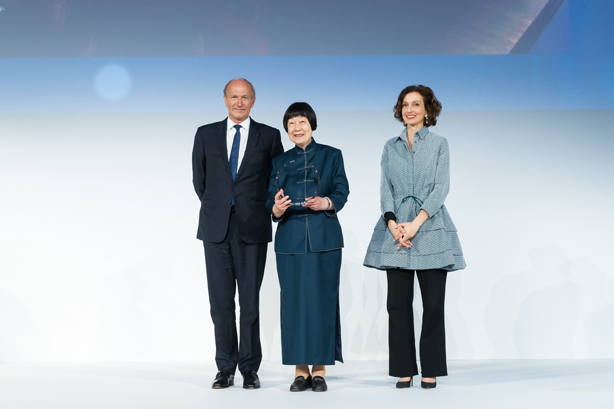
Dr. CHANG Mee-mann (middle) receives the L’Oréal-UNESCO Award for Women in Science in Paris from Mr. Jean-Paul Agon (left), Chairman and CEO of L’Oréal and Ms. Audrey Azoulay (right), Director-General Secretary of UNESCO. (Photo: UNESCO)
Chosen by UNESCO and the L’Oréal Foundation as one of the five recipients of the prestigious awards for outstanding female scientists, she won this honor due to “her pioneering work on fossil records leading to insights on how aquatic vertebrates adapted to life on land.”
CHANG’s research over the past 50 years has contributed significantly to our understanding of the evolution of vertebrate species, helping clarify the links between the fishes that swam in Earth’s oceans 400 million years ago and the air-breathing, land-walking creatures that evolved from them. Meanwhile, her research has brought the once little-known Chinese fossil fishes to the attention of the scientific world.
Story Coded in Fossil Record
CHANG has spent years studying the fish faunas and paleoenvironments of the sedimentary basins in China’s eastern coastal provinces. Her research covers broad areas of taxonomy, phylogeny, zoogeography, paleoecology, and biostratigraphy of the late Mesozoic and Cenozoic (from approximately 130 to 50 million years before present) fish faunas. These faunas are quite characteristic and consist predominantly of primitive teleosts or higher bony fishes, some of which may be ancestral types of the modern groups. Based on her studies of fossil fishes, she determined the ages and paleoenvironments of the fossil-bearing deposits.
CHANG’s research also helps understand the distribution of fish species across the Pacific Ocean – a distribution that reached its maximum during the Eocene epoch, between 34 million and 56 million years ago. Most of these fishes became extinct in the western Pacific, she notes, but a few, such as the coelacanth, still live in the eastern Pacific. “Tracing the origins and distribution of these fishes is a very exciting endeavour,” she says.
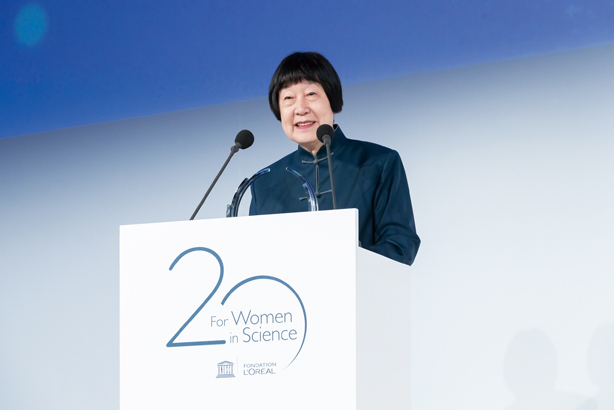
Dr. CHANG addresses the ceremony.
However, CHANG’s most important contributions to science have been her studies of the cranial anatomy of the earliest sarcopterygians (lobe-finned fishes and tetrapods) from the Early Devonian deposits of eastern Yunnan Province, namely Youngolepis and Diabolepis. Using serial thin sectioning and enlarged wax models, she investigated in exquisite detail the fine structures of fishes that lived about 400 million years ago.
By 1982, she had finished reconstructing the 3D cranial structure of Youngolepis, and found a series of features characteristic for both distinct lineages (lungfish and lobe-finned fish) in the inner structure of the skull of Youngolepis, and, unexpectedly, the lack of internal nostril that excludes the possibility for this form to be any direct predecessor of the tetrapods. Further, she studied the morphology of Diabolepis, which was closer to lungfish than tetrapods. These studies caused some kind of sensational effect in the circle of the early fish specialists, and gave an impetus to reconsidering the whole evolutionary history of the sarcopterygians and the origin of the tetrapods.
This is the classic Stockholm School at its best and CHANG’s benchmark studies on sarcopterygians have drawn widespread lauds. Supported with solid evidence, her studies have furthered our understandings of early evolutionary history of vertebrates and the distant origin of tetrapods.
CHANG’s latest work on an extraordinarily thick-boned Pliocene mountain carp from Tsaidam linked the thick-bone phenomenon to the aridification of the source area, and drew important paleozoogeographic and evolutionary conclusions based on its comparison with the mountain carps now living in the Yunnan Province.
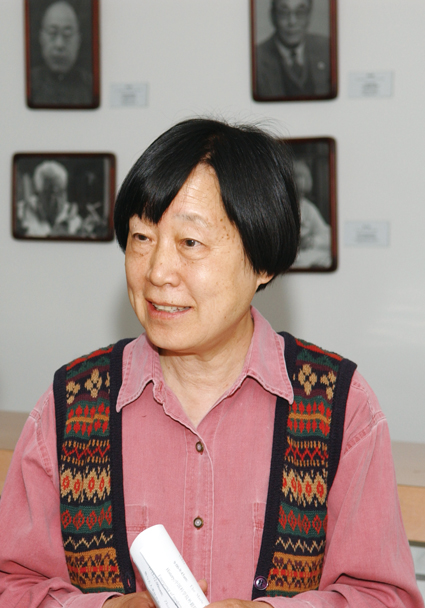
Dr. CHANG Mee-Mann
Another important find of CHANG was the Early Cretaceous lamprey from the famous Jehol biota, filling the immense gap in the fossil record of lampreys between the Carboniferous Period and the recent.
A paleontologist and evolutionary biologist, CHANG graduated from Romonosov Moscow State University in 1960 and received her PhD from Stockholm University in 1982. She has since been a research professor at IVPP and served as the director of the institute from 1983 to 1991. The year 1991 saw her elected as a Member of the Chinese Academy of Sciences, the highest academic honor in China for a scientist. Later she was elected President of the International Paleontological Association in 1992, and President of the Paleontological Society of China in 1993. Due to her academic distinction, she also owns Foreign Fellowship of the Linnaean Society of UK and the Royal Swedish Academy of Sciences. In 2016, she won the Romer-Simpson Lifetime Achievement Award, the highest honor of international vertebrate paleontology.
Early Exposure to Paleontology
A frequent winner of prestigious awards and prizes, CHANG has travelled a road far from straight-forward in her pursuit of science. Along with her successes, she has faced significant difficulties, but her enthusiasm for her subject remains undimmed. “I am still working on fish specimens, and love digging and collecting fossil fishes in the field,” she smiles when recollecting her experiences during an interview in her office at IVPP in Beijing.
CHANG’s father, a gifted pathologist from Nanjing, encouraged her to become a physician, but the love for her country drove her to choose geology instead, which she thought would play a vital role in rebuilding the war-torn country. In 1958, during the “Great Leap Forward,” she was among those who conformed to the call of then vice-president of China, Mr. LIU Shaoqi to study geosciences, which in LIU’s eye would help China better exploit its natural resources, such as oil. For CHANG, that introduction to China’s rocks set her on the path to study fossil fishes. “I started to study Paleontology some 60 years ago when I was a student in Romonosov Moscow State University. At that time, my choice of career was even not own. It was arranged, much as an arranged marriage (in ancient China),” she says in her address at the awarding ceremony in Paris. “It is truly fascinating to be able to figure out what a new fossil is, how it is related to other organisms, how it lived, and what it can tell us about the ancient environment,” she continues.
In 1965, CHANG was chosen to do advanced study at the Swedish Museum of Natural History in Stockholm, one of the leading research centers in paleontology. But her visit there was to prove short-lived. When the Cultural Revolution swept China in 1966, CHANG, ever a patriot, halted her studies and returned home. In Beijing, CHANG was confronted by the new phenomenon of the “Red Guards” who ‘purified’ China by isolating and punishing the academics.
CHANG’s passion for academic exploration survived all the thicks and thins, and her perseverance and efforts did not let her down. Due to her academic distinction, CHANG was elected a foreign member of the Linnaean Society of London in 1995, an honorary member of the Society of Vertebrate Paleontology in 1997, and a foreign member of the Royal Swedish Academy of Sciences. She also received an honorary degree from the University of Chicago in 2011, an honorary degree from the Richard Gilder Graduate School of the American Museum of Natural History in 2015, and won the Romer-Simpson Lifetime Achievement Award in 2016.
Her pursuit of science has taken her through many countries. This allowed her to pick up numerous languages. Earning her undergraduate degree at the Romonosov Moscow State University, she became fluent in Russian; She learned modest Swedish while in Stockholm and is now fluent in English and reads in both German and French. CHANG played an instrumental role in reviving paleontological research in China after the “Culture Revolution,” nurturing Chinese graduate students in paleontology, and has assumed a pivotal role in fostering international collaborations.
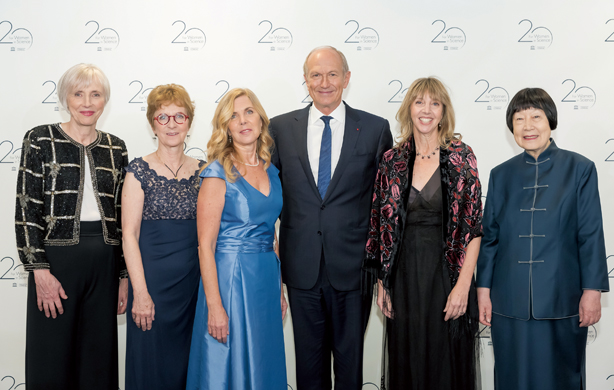
Dr. CHANG poses with other award winners and Mr. Jean-Paul Agon (center), Chairman and CEO of L’Oréal. (Photo: UNESCO)
Raising Social Awareness of Women in Science
Jointly established in 1998 by UNESCO and the L’Oréal group, the L’Oréal-UNESCO Awards for Women in Science aims to promote gender equality in science by recognizing outstanding women researchers who have contributed to scientific progress. Annually this program awards five women scientists, each representing one continent. The other four winners this year are Heather Zar from South Africa, Caroline Dean of Britain, Amy Austin from Argentina and Janet Rossant from Canada. Also awarded annually are 15 promising young women scientists as UNESCO-L’Oréal International Rising Talents.
Females have long been under-represented in the field of science, and their ambitions in academic career are often frustrated by the so-called “glass ceiling.” What shall be done to change this?
“Education might be of the most importance,” commented CHANG when asked what should be done to promote gender equality in science and encourage more females to dedicate themselves to this cause.
“In the case of China, traditionally if a family can only afford to send one child to school, generally this very dear opportunity would go to a son, rather than a daughter. Now the situation is getting better, particularly in urban areas. However, to some extent this remains true; sometimes, daughters of a family, no matter how well they perform at school, still would lose this opportunity to their younger or elder brother, the chosen one to enjoy decent education; in some cases, they might even need to work to support the family or their brother at school,” she continued. “Things will not improve if this stays unchanged. Without equal opportunity in education, females will stay under-represented in any field, let alone science,” she asserted.
In the field of science, she furthered, if endowed with equal opportunities, females will make equally important contributions as males.
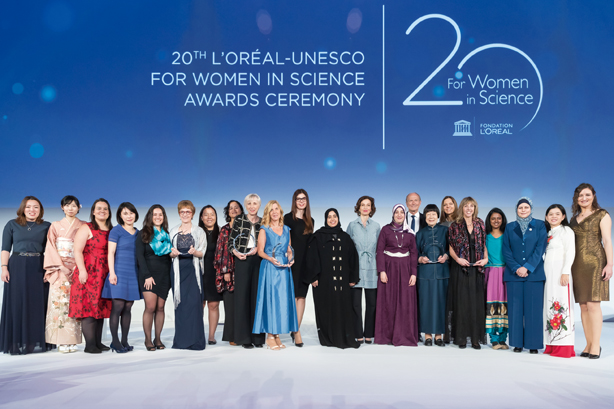
Dr. CHANG celebrates science excellence of women together with other laureates of the L’Oréal-UNESCO Award for Women in Science and the recipients of UNESCO-L’Oréal International Rising Talents at the ceremony.
March 22, 2018, at a ceremony held in Paris to celebrate the 20th anniversary of the L’Oréal-UNESCO For Women in Science program, Dr. CHANG Mee-mann (ZHANG Miman) received the L’Oréal-UNESCO Award for Women in Science from Mr. Jean-Paul Agon, Chairman and CEO of L’Oréal, and Ms. Audrey Azoulay, Director-General of UNESCO.

